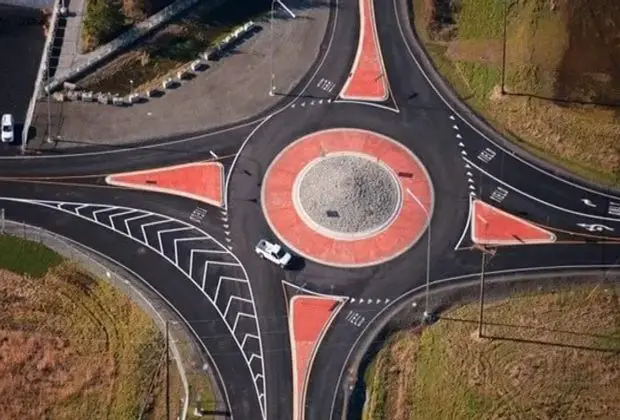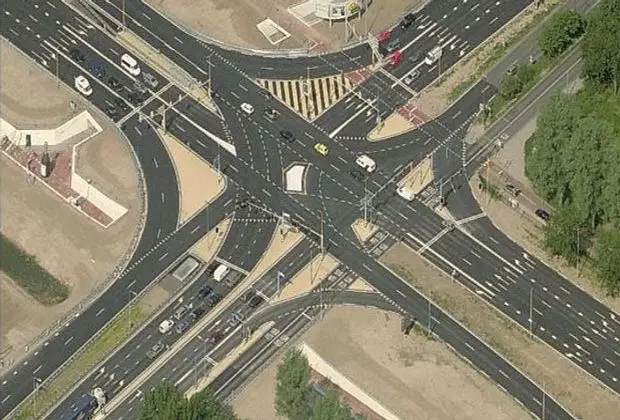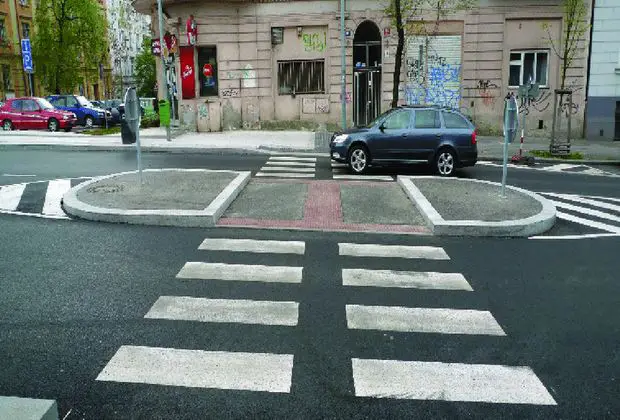What is Traffic Island?
Traffic islands are painted or solid structure that is placed on a road to control traffic. These islands can be an either circular or narrow strip that runs between two roads at an acute angle. A painted island is one that uses only road markings without Krebs or other obstacles.
Traffic Island Types
The different types of traffic islands are as follows:
- Rotary or Central Traffic Islands
- Channelizing Traffic Islands
- Divisional Traffic Island
- Refuge Traffic Island
1. Rotary or Central Traffic Islands

A revolving or center island is a type of traffic island that is placed at the intersection to make traffic move in the opposite direction. This is also known as a rotary island or center island. To eliminate conflict points and to ensure smooth traffic flow, they are placed in the middle of road intersections.
Rotary or central traffic Islands can only be constructed if there is sufficient space at the intersection. Usually, the shape of the Island is determined by the type of road junction.
Rotary traffic islands usually come in the following forms:
- Circular Rotating Island.
- Square with round side rotating island.
- Elliptical, elongated, or oval rotating island.
- Rectangular rotating island.
2. Channelizing Traffic Island

It is a type of traffic island that acts as a channelizer and guides the directions of the vehicles. Channelizing islands are used to allow smooth and rapid rotation of traffic and prevent interference by other moving cars.
It shows the intersections of roads, which helps to reduce conflict and facilitates rapid integration and diversification.
This type of traffic island is visible in the form of elevated or marked-off areas or a painted island or a pedestrian zone.
3. Divisional Traffic Island

Usually, this type of traffic island can be seen along the road. These structures can be used to impede traffic from moving in the opposite direction, but they are also be used as dividers.
4. Refuge Traffic Island

The refuge islands are for pedestrians and not vehicles. It allows pedestrians to wait until the vehicle movement stops before crossing the road.
It is large and provides safe areas for pedestrians. These structures are elevated structures that can be climbed along roads and are large enough to allow a person or group to stand.
Also Read – Highway engineering MCQ PDF | Download for Free
Traffic Islands Design Considerations
Following are some key considerations to be taken before constructing a traffic island:
a. Type of Island
The transportation department decides which type of island should be built. This considers many factors, including cost, traffic volume, durability, and others.
The majority of painted traffic islands are used if traffic volume is low. But concrete structures are used when traffic volume is high.
b. Location
It is necessary to consider the island location, As different traffic islands can be found in different places. Some are located on the roadside, while others are in the middle of the road.
The most important factor in determining the location of an island is its functional layout and traffic volume.
c. Shape and Size
You must consider the size and shape of the traffic islands that will be built on the road. The function of each traffic island is determined by its size and shape. A median traffic island is a traffic island that is longer than it is wide. Its function is to divide traffic flow.
A channelizer has a traffic island that directs traffic in one direction. A rotary traffic island can be as round or circular as it rotates. The ring gives drivers more maneuverability.
Also Read – Roads and Highways – Types of Highway Planning Surveys

